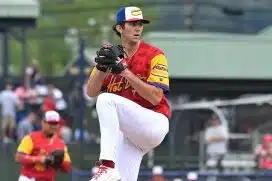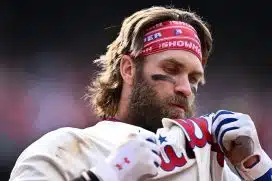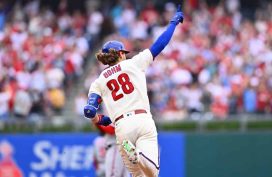By Tim Kelly, Sports Talk Philly editor
Philadelphia Phillies managing partner John Middleton told Jim Salisbury of NBC Sports Philadelphia last month that he agreed with the narrative that first-year manager Gabe Kapler was pushing this Spring Training – the Phillies should be in the playoff hunt in 2018. To do that, Middleton said, some players had to take a step forward. While Middleton didn't identify Nick Pivetta and Vince Velasquez by name, they probably were among the players he was thinking of. And so far, they've done more than just take a step forward in 2018.
At the time of publication of this article, Pivetta's 1.32 FIP leads all major league starters. Velasquez, who turned in one of the best starts of his career in a win over the Tampa Bay Rays Friday night, has the league's third best FIP, at 1.63. While both are among the starting pitching leaders in fWAR and grade out well across early-season statistical leaderboards, it really is FIP that stands out.
This isn't a case of handpicking a favorable statistic to create a narrative. FIP eliminates any luck that pitchers may have over a small sample size due to impressive fielding behind them. As FanGraphs notes, FIP "is based on outcomes that do not involve defense; strikeouts, walks, hit by pitches and home runs allowed." This makes it typically successful in predicting future regression, either positive or negative.
Phillies Nuggets: Hernandez Forcing Way Into Long-Term Discussion
For example, from a traditional statistics perspective, Jeremy Hellickson got off to an excellent start for the Phillies in 2017. Across his first 38.2 innings of 2017, Hellickson went 4-1 with a 3.49 ERA in April of 2017. Based off of that alone, one may have predicted that Hellickson was headed for a career year in his second consecutive contract year. However, as SportsTalkPhilly.com's Jason Ferrie pointed out at the time, Hellickson's 5.34 FIP suggested that a negative regression was on its way. His xFIP, which is a projection of what a pitcher's FIP will be based on how he has performed in a given season, was 5.44.
Sure enough, Hellickson's second season with the Phillies turned into a relative disaster. In 112.1 innings across 20 starts for the Phillies in 2017, Hellickson posted a 4.73 ERA. After the Phillies traded him to the Baltimore Orioles prior to the July 31 non-waiver trade deadline, Hellickson posted a 6.97 ERA in 10 starts. In total, Hellickson posted a 5.43 ERA in 2017, eerily close to the 5.34 FIP and 5.44 xFIP that he had in early May.
This isn't to say that Pivetta or Velasquez will finish the season with an ERA below 2.00. It is to say that Pivetta and Velasquez haven't been lucky through each of their first three starts, they've just been really good. And that's been a pleasant development for the Phillies, who have won eight of their last ten games.
***
Pivetta, who many thought was over-reliant on his fourseam fastball in 2017, hasn't drastically changed his approach against left-handed hitters. Brooks Baseball says that Pivetta used his fourseam fastball in 67 percent of all counts against left-handed hitters in 2017. Through his first 16.2 innings in 2018, he's using it in 66 percent of all counts against left-handed hitters. If anything, Pivetta is actually using his fourseam fastball more in an attempt to put left-handed hitters away, as his usage of the pitch has increased by over 10 percent when he's up in the count and/or when he's already thrown two strikes to a hitter:
| Fastball Usage Vs. LHH | 2017 | 2018 |
| All Counts | 77 | 66 |
| Pitcher Ahead | 52 | 66 |
| Two Strikeouts | 57 | 68 |
However, the 25-year-old's approach against right-handed pitchers has changed in 2018. While the trend of him using his fourseam fastball more frequently when he's ahead in counts also appears against right-handed hitters, Pivetta isn't using his four-seam fastball as frequently overall when facing right-handed hitters. In 2017, Pivetta used his fourseam fastball 66 percent of the time against right-handed hitters. In 2018, Pivetta is using his fourseam fastball in just 51 percent of all counts against right-handed hitters.
This means that Pivetta is relying more upon his secondary pitches against right-handed batters in 2018. While he still almost never uses his change-up against right-handed hitters – he used it one percent in 2017 and is using it at the same pace in 2018 – Pivetta is now using his slider and curveball 24 percent of the time (each) in all counts against right-handed batters.
The curveball has seen its biggest spike in usage early in counts, as Pivetta is now using his curveball on 31 percent of first pitches to right-handed hitters, as opposed to 15 percent of first pitches to right-handed hitters in 2017.
In total, Pivetta is using his curveball 26 percent of the time in 2018, as opposed to just under 16 percent in 2017. Even against left-handed hitters, Pivetta is now using his curveball 13 percent more frequently than he did a year ago. Pitching coach Rick Kranitz and the Phillies coaching staff seem to have urged Pivetta to mix in his curveball more frequently earlier in the count in 2018, keeping hitters honest before he tries to bury them with his fourseam fastball. It's been a small sample size, but so far, so good for Pivetta in 2018.
***
Velasquez, once the key piece acquired in the December 2015 Ken Giles trade, looked headed for a career crossroads just a couple of weeks ago. Following a very disappointing 2017 season, the 25-year-old right-hander lasted just 2.2 innings in his first start of the 2018 season, allowing nine hits and four earned runs in a 15-2 loss to the Atlanta Braves.
The Phillies welcomed the Miami Marlins to Citizens Bank Park for Velasquez's second start of the season one week later. Velasquez didn't get off to an especially encouraging start, allowing a run in the top of the first and using 26 pitches to get through just one inning.
The Phillies offense ultimately exploded in support of Velasquez, so there wasn't a question of whether he would be able to hold the lead for the Phillies. Rather, the rest of the game acted as an audition for Velasquez.
With Pivetta off to a hot start, Lively having been serviceable in his first start and Jerad Eickhoff expected to return from the disabled list at some point in May, Velasquez needed a chance to exhale. He has two remaining options, and after his start in Atlanta it felt like a realistic possibility that the Phillies may have to use one to send Velasquez to Triple-A. Time in Triple-A would allow for one of two scenarios to take place. Scenario one would be that Velasquez would pitch at Triple-A for a while just as a chance to mentally reset, not that different from what Brett Myers did during the 2008 season. (It's worth noting that Myers had much more career success prior to his demotion – one that he had to sign off on – than Velasquez has.) The other scenario would be that the Phillies would bring an end to Velasquez starting altogether and attempt to convert him into a reliever. Neither scenario would be ideal.
Trending: Jake Arrieta "Feels Good" About Chances Phillies Opt Into Final Two Years Of Contract
Then a funny thing happened: Velasquez really began to just pitch. After throwing 77 pitches in his first four innings, Velasquez used a more aggressive approach to last six innings, throwing 21 pitches over his final two frames. He carried that with him to Tampa Bay, where he turned in one of his best starts to date, striking out seven, while allowing just four hits and one run over six innings. Friday was the first time that Velasquez turned in consecutive starts of at least six innings and less than one earned run since his first two starts with the Phillies in April of 2016.
Could these two starts just be a blip on the radar? Sure, but on top of utilizing a more aggressive approach, Velasquez also has increased his curveball usage and appears to be finding success because of it.
After using his curveball 12 percent of the time to left-handed hitters in 2017, Velasquez has doubled his curveball usage to left-handed hitters, throwing it at a 24 percent clip in 2018.
The interesting thing about the curveball is that in a box, it's actually been an ineffective pitch for Velasquez. For example, in Friday night's start, Velasquez gave up four hits, three of which came against the curveball. Still, Velasquez, in his limited usage of his slider, changeup and sinker, didn't give up a single hit Friday night. He only allowed one hit when using his fourseam fastball, while striking out four. It may be that while Velasquez's curveball isn't overly effective on its own, his other pitches become more effective when he mixes the curveball in at a higher rate.
Like Pivetta, Velasquez's success should be taken with a grain of salt. He's made only three starts this season, and unlike Pivetta, his first start was an unmitigated disaster. His second start didn't look promising through the first few innings. And yet, after three starts, we are no longer talking about Velasquez being demoted or moved to the bullpen. We're talking about him, along with Pivetta, having had one of the best starts to the 2018 season among starting pitchers.
Phillies Aesthetics
This Thursday, the Philadelphia Phillies will host their first "Throwback Thursday" promotion of the 2018 season. The Phillies will don their ever-popular powder blue throwback jerseys when they host the Pittsburgh Pirates at Citizens Bank Park. All fans 15 and over will get a Nick Williams powder blue "shirsey." (That should be a fun promotional day if he isn't in the lineup, huh?)
Elsewhere in organizational aesthetics, the Lehigh Valley IronPigs, the Phillies Triple-A affiliate, announced last week that on Sundays during the 2018 season, they will wear jerseys inspired by the 1979 Phillies red jerseys:
🚨🚨🚨NEW JERSEY ANNOUNCEMENT🚨🚨🚨
We're paying homage to the 1979 @Phillies with our new Sunday threads. pic.twitter.com/XzXvEDBjXJ
— IronPigs (@IronPigs) April 11, 2018
In 1979, the Phillies wore red-on-red jerseys for Saturday night home games. The "Saturday Night Special" jerseys inspired the latest IronPigs jersey, though, thankfully, the IronPigs are leaving the red pants in 1979:
Phillies haven’t worn red in the regular season since… OH GOD. pic.twitter.com/JLaXKmVIoQ
— Matt Gelb (@MattGelb) February 1, 2016
One thing the Phillies should bring back from that era: the jackets with each player/coach's name on the back. The late Dallas Green models the jacket below:
The Nuggets
- Scott Kingery launched the Phillies third grand slam of the year last Tuesday, April 10. The 2017 Phillies didn't hit their third grand slam of the season until Aug. 19, when Ty Kelly hit a grand slam against the Giants in the 121st game of the season. Kelly – the second most relevant "T. Kelly" associated with the Phillies – is currently hitting .395 with 11 RBIs for the Las Vegas 51s, the New York Mets Triple-A affiliate.
- Between January 1, 2017 and April 14, 2017, the Phillies, Eagles and Sixers combined for 23 regular season/postseason wins. Between January 1, 2018 and April 14, 2018, the Phillies, Eagles and Sixers combined for 47 regular season/postseason wins (and a Lombardi Trophy).
- I spent an afternoon rewatching Game 7 of the 1997 World Series last week. The Phillies connections in the series were amazing: Darren Daulton, Jose Mesa, Jim Thome, Charlie Manuel, Chad Ogea, Antonio Alfonseca, Jeff Conine and Jim Eisenreich all were involved in one of the greatest World Series of all-time.
- The last time that the Phillies scored nine or more runs three times in their first 15 games was 2011. For those of you scoring at home, that was a pretty good season for the Phillies.
- Cesar Hernandez reached base twice in Sunday's 10-4 win over the Rays. It was the ninth time this season that Hernandez has reached base multiple times.
- On this week in Phillies history: the late Roy Halladay, squaring off with Tim Hudson and the Atlanta Braves, threw a five-hit, complete game shutout. That came on April 21, 2010 and was already Halladay's second complete game of the season. It improved his record in his first season with the Phillies to 4-0, and he brought an 0.82 ERA along with it. Halladay would win his second Cy Young Award that year.
- Under Pete Mackanin, the 2017 Phillies finished 25th in the league with 0.36 steals per game. As evidenced by the fact that Rhys Hoskins already has three stolen bases, Gabe Kapler's Phillies have placed much more of an emphasis on swiping bags. The Phillies are currently third in the majors with 0.85 stolen bases per game. Seven different Phillies have stolen bases, with Hoskins and Hernandez tied for the team lead at three.
- Jon Heyman of FanRag Sports noted over the weekend that Phillies icon Carlos Ruiz continues to play baseball in his native Panama. The feeling here is that if a team like the Rangers or Mets hasn't already reached out to Ruiz, it's pretty unlikely anyone will. Ruiz, 39, slashed .216/.313/.352 in 125 at-bats for the Seattle Mariners in 2017, while still posting a 0.5 fWAR. If he chooses, there will no doubt be interest in him as a coach in the near future.







